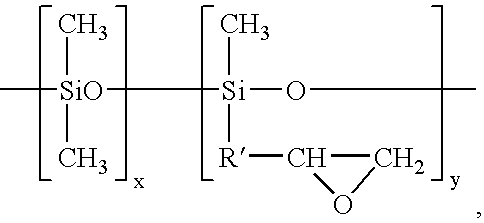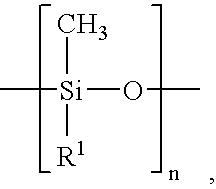Method for producing organic electroluminescent device and transfer material used therein
a technology of electroluminescent devices and transfer materials, which is applied in the manufacture of electrode systems, electric discharge tubes/lamps, other domestic objects, etc., can solve the problems of poor productivity, insufficient durability of organic light-emitting devices, and serious problems, and achieve good adhesion interface, good light-emitting efficiency, and low cost
- Summary
- Abstract
- Description
- Claims
- Application Information
AI Technical Summary
Benefits of technology
Problems solved by technology
Method used
Image
Examples
example 2
[0189] A transfer material and an organic electroluminescent device were produced and evaluated in the same manner as in Example 1 except for using a coating solution 2 for a peeling layer having a composition of 18 parts by mass of a polyester resin HP301 having a glass transition temperature of 62.degree. C. and a softening point of 105.degree. C. available from The Nippon Synthetic Chemical Industry Co., Ltd., 2 parts by mass of silicone (Orgatics SI220 available from Matsumoto Trading Co., Ltd.) reacting with a peeling layer-forming resin, 40 parts by mass of methyl ethyl ketone, and 40 parts by mass of toluene, in place of the coating solution 1 for a peeling layer. The results are shown in Table 1.
example 3
[0190] A transfer material and an organic electroluminescent device were produced and evaluated in the same manner as in Example 1 except for using a coating solution 3 for a peeling layer having a composition of 17 parts by mass of a polyester resin HP320 having a glass transition temperature of 62.degree. C. and a softening point of 95.degree. C. available from The Nippon Synthetic Chemical Industry Co., Ltd., 3 parts by mass of silicone oil KF54 available from Shin-Etsu Chemical Co., Ltd., 40 parts by mass of methyl ethyl ketone, and 40 parts by mass of toluene, in place of the coating solution 1 for a peeling layer. The results are shown in Table 1.
example 4
[0191] A transfer material and an organic electroluminescent device were produced and evaluated in the same manner as in Example 1 except for using a coating solution 4 for a peeling layer having a composition of 15 parts by mass of a polyester resin HP301 having a glass transition temperature of 62.degree. C. and a softening point of 105.degree. C. available from The Nippon Synthetic Chemical Industry Co., Ltd., 5 parts by mass of vinyl-modified silicone XF40-A1987 available from GE Toshiba Silicones Co., Ltd., 0.01 part by mass of a platinum catalyst, 40 parts by mass of methyl ethyl ketone, and 40 parts by mass of toluene, in place of the coating solution 1 for a peeling layer. The results are shown in Table 1.
PUM
| Property | Measurement | Unit |
|---|---|---|
| Thickness | aaaaa | aaaaa |
| Thickness | aaaaa | aaaaa |
| Thickness | aaaaa | aaaaa |
Abstract
Description
Claims
Application Information
 Login to View More
Login to View More - R&D
- Intellectual Property
- Life Sciences
- Materials
- Tech Scout
- Unparalleled Data Quality
- Higher Quality Content
- 60% Fewer Hallucinations
Browse by: Latest US Patents, China's latest patents, Technical Efficacy Thesaurus, Application Domain, Technology Topic, Popular Technical Reports.
© 2025 PatSnap. All rights reserved.Legal|Privacy policy|Modern Slavery Act Transparency Statement|Sitemap|About US| Contact US: help@patsnap.com



